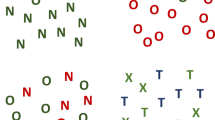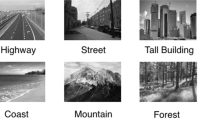Abstract
The ability of monkeys to categorize objects in visual stimuli such as natural scenes might rely on sets of low-level visual cues without any underlying conceptual abilities. Using a go/no-go rapid animal/non-animal categorization task with briefly flashed achromatic natural scenes, we show that both human and monkey performance is very robust to large variations of stimulus luminance and contrast. When mean luminance was increased or decreased by 25–50%, accuracy and speed impairments were small. The largest impairment was found at the highest luminance value with monkeys being mainly impaired in accuracy (drop of 6% correct vs. <1.5% in humans), whereas humans were mainly impaired in reaction time (20 ms increase in median reaction time vs. 4 ms in monkeys). Contrast reductions induced a large deterioration of image definition, but performance was again remarkably robust. Subjects scored well above chance level, even when the contrast was only 12% of the original photographs (≈81% correct in monkeys; ≈79% correct in humans). Accuracy decreased with contrast reduction but only reached chance level -in both species- for the most extreme condition, when only 3% of the original contrast remained. A progressive reaction time increase was observed that reached 72 ms in monkeys and 66 ms in humans. These results demonstrate the remarkable robustness of the primate visual system in processing objects in natural scenes with large random variations in luminance and contrast. They illustrate the similarity with which performance is impaired in monkeys and humans with such stimulus manipulations. They finally show that in an animal categorization task, the performance of both monkeys and humans is largely independent of cues relying on global luminance or the fine definition of stimuli.








Similar content being viewed by others
References
Albrecht DG, Geisler WS, Frazor RA, Crane AM (2002) Visual cortex neurons of monkeys and cats: temporal dynamics of the contrast response function. J Neurophysiol 88:888–913
Avidan G, Harel M, Hendler T, Ben-Bashat D, Zohary E, Malach R (2002) Contrast sensitivity in human visual areas and its relationship to object recognition. J Neurophysiol 87:3102–3116
Bar M (2004) Visual objects in context. Nat Rev Neurosci 5:617–629
Bentin S, Allison T, Puce A, Perez E, McCarthy G (1996) Electrophysiological studies of face perception in humans. Journal of Cognitive Neuroscience 8:551–565
Brady TF, Konkle T, Alvarez GA, Oliva A (2008) Visual long-term memory has a massive storage capacity for object details. Proc Natl Acad Sci U S A 105:14325–14329
Bullier J (2001) Integrated model of visual processing. Brain Res Brain Res Rev 36:96–107
D’Amato MR, Van Sant P (1988) The person concept in monkeys (Cebus apella). J Exp Psychol Anim Behav Process 14:43–55
Delorme A, Richard G, Fabre-Thorpe M (2000) Ultra-rapid categorisation of natural scenes does not rely on colour cues: a study in monkeys and humans. Vision Res 40:2187–2200
Delorme A, Rousselet GA, Macé MJ, Fabre-Thorpe M (2004) Interaction of top-down and bottom-up processing in the fast visual analysis of natural scenes. Brain Res Cogn Brain Res 19:103–113
Fabre-Thorpe M, Richard G, Thorpe SJ (1998) Rapid categorization of natural images by rhesus monkeys. Neuroreport 9:303–308
Fabre-Thorpe M, Delorme A, Marlot C, Thorpe S (2001) A limit to the speed of processing in ultra-rapid visual categorization of novel natural scenes. J Cogn Neurosci 13:171–180
Fagot J, Cook RG (2006) Evidence for large long-term memory capacities in baboons and pigeons and its implications for learning and the evolution of cognition. Proc Natl Acad Sci U S A 103:17564–17567
Farah MJ, Wilson KD, Drain M, Tanaka JN (1998) What is “special” about face perception? Psychol Rev 105:482–498
Gegenfurtner KR, Rieger J (2000) Sensory and cognitive contributions of color to the recognition of natural scenes. Curr Biol 10:805–808
Girard P, Jouffrais C, Kirchner H (2008) Ultra-rapid categorisation in non-human primates. Anim Cogn 11:485–493
Herrnstein RJ, Loveland DH (1964) Complex Visual Concept in the Pigeon. Science 146:549–551
Huber L, Lenz R (1993) A test of the linear feature model of polymorphous concept discrimination with pigeons. Q J Exp Psychol 46B:1–18
Huber L, Troje NF, Loidolt M, Aust U, Grass D (2000) Natural categorization through multiple feature learning in pigeons. Q J Exp Psychol B 53:341–357
Kaplan E, Shapley RM (1986) The primate retina contains two types of ganglion cells, with high and low contrast sensitivity. Proc Natl Acad Sci U S A 83:2755–2757
Macé MJ, Thorpe SJ, Fabre-Thorpe M (2005a) Rapid categorization of achromatic natural scenes: how robust at very low contrasts? Eur J Neurosci 21:2007–2018
Macé MJ, Richard G, Delorme A, Fabre-Thorpe M (2005b) Rapid categorization of natural scenes in monkeys: target predictability and processing speed. Neuroreport 16:349–354
Macé MJ, Joubert OR, Nespoulous J-L, Fabre-Thorpe M (2009) The time-course of visual categorizations: you spot the animal faster than the bird. PLoS One 4(6):e5927 http://dx.plos.org/10.1371/journal.pone.0005927
Martin-Malivel J, Fagot J (2001) Cross-modal integration and conceptual categorization in baboons. Behav Brain Res 122:209–213
Martin-Malivel J, Mangini MC, Fagot J, Biederman I (2006) Do humans and baboons use the same information when categorizing human and baboon faces? Psychol Sci 17:599–607
Minamimoto T, La Camera G, Richmond BJ (2009) Measuring and Modeling the Interaction Among Reward Size, Delay to Reward, and Satiation Level on Motivation in Monkeys. J Neurophysiol 101:437–447
Pong M, Fuchs AF (2000) Characteristics of the pupillary light reflex in the macaque monkey: metrics. J Neurophysiol 84:953–963
Roberts WA, Mazmanian DS (1988) Concept learning at different levels of abstraction by pigeons, monkeys, and people. J Exp Psychol Anim Behav Process 14:247–260
Rolls ET, Baylis GC (1986) Size and contrast have only small effects on the responses to faces of neurons in the cortex of the superior temporal sulcus of the monkey. Exp Brain Res 65:38–48
Rosch E, Mervis CB, Gray WD, Johnson DM, Boyes-Braem P (1976) Basic objects in natural categories. Cogn Psychol 8:382–439
Schyns PG, Oliva A (1994) From blobs to boundary edges—evidence for time-scale-dependent and spatial-scale-dependent scene recognition. Psychological Science 5:195–200
Sherman SM (1985) Functional organization of the W-, X- and Y-cell pathways in the cat: a review and hypothesis. In: Sprague JM, Epstein AN (eds) Progress in psychobiology and physiological psychology, vol 11. Academic Press, New York, pp 233–314
Spence I, Wong P, Rusan M, Rastegar N (2006) How color enhances visual memory for natural scenes. Psychol Sci 17:1–6
Strasburger H, Rentschler I (1996) Contrast-dependent dissociation of visual recognition and detection fields. Eur J Neurosci 8:1787–1791
Strasburger H, Harvey LO Jr, Rentschler I (1991) Contrast thresholds for identification of numeric characters in direct and eccentric view. Percept Psychophys 49:495–508
Troje NF, Huber L, Loidolt M, Aust U, Fieder M (1999) Categorical learning in pigeons: the role of texture and shape in complex static stimuli. Vision Res 39:353–366
Vogels R (1999) Categorization of complex visual images by rhesus monkeys. Part 1: behavioural study. Eur J Neurosci 11:1223–1238
Von Fersen L, Lea SEG (1990) Category discrimination by pigeons using five polymorphous features. J Exp Anal Behav 54:69–84
Wichmann FA, Sharpe LT, Gegenfurtner KR (2002) The contributions of color to recognition memory for natural scenes. J Exp Psychol Learn Mem Cogn 28:509–520
Winn B, Whitaker D, Elliott DB, Phillips NJ (1994) Factors affecting light-adapted pupil size in normal human subjects. Invest Ophthalmol Vis Sci 35:1132–1137
Yao AY, Einhauser W (2008) Color aids late but not early stages of rapid natural scene recognition. J Vis 8(12):11–13
Acknowledgments
This work was supported by the CNRS, the University Paul Sabatier (Toulouse III), the French government and the “Programme Cognitique”. We would like to thank S. Thorpe for helpful comments and corrections.
Author information
Authors and Affiliations
Corresponding author
Rights and permissions
About this article
Cite this article
Macé, M.JM., Delorme, A., Richard, G. et al. Spotting animals in natural scenes: efficiency of humans and monkeys at very low contrasts. Anim Cogn 13, 405–418 (2010). https://doi.org/10.1007/s10071-009-0290-4
Received:
Revised:
Accepted:
Published:
Issue Date:
DOI: https://doi.org/10.1007/s10071-009-0290-4




